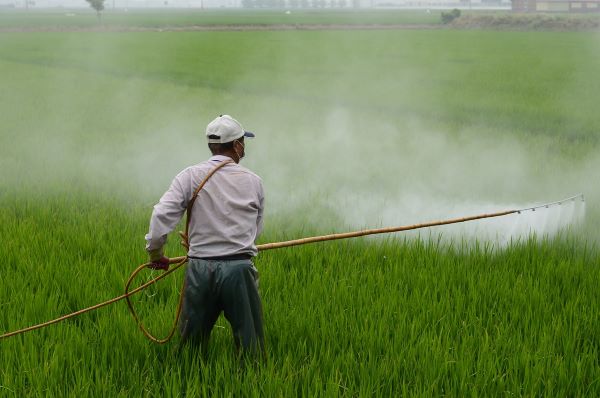Malathion is a widely used pesticide known for its effectiveness in controlling a variety of pests. Its extensive application in agriculture, particularly in vegetable cultivation, has made it a staple in pest management. However, like many pesticides, Malathion poses risks to human health and the environment. This article provides a comprehensive overview of Malathion, including its description, usage, risks, and regulatory status in India and globally.
What is Malathion?
Malathion is an organophosphate insecticide that has been used since the 1950s to control a wide range of insects. Chemically known as diethyl (dimethoxythiophosphorylthio) succinate, Malathion works by inhibiting the activity of acetylcholinesterase, an enzyme essential for the proper functioning of the nervous system in insects. This inhibition leads to the accumulation of acetylcholine, causing paralysis and death in pests. (Source)
Also, read: All You Need to Know About Paraquat, A Common Pesticide Used in Vegetables
Description and Usage
Description: Malathion is available in various formulations, including liquid concentrates, dusts, and wettable powders. It can be applied using various methods, such as spraying and dusting, depending on the specific requirements of the crop and the target pests. (Source)
Usage: Malathion is used in a wide range of agricultural and non-agricultural settings:
- Vegetables: Commonly used on crops like tomatoes, cucumbers, and leafy greens to control aphids, spider mites, and whiteflies.
- Fruits: Applied to orchards of fruits such as apples, peaches, and grapes to manage pests like fruit flies and moths.
- Field Crops: Used in the cultivation of crops such as cotton, rice, and maize to control a variety of insect pests.
- Public Health: Employed in mosquito control programs to reduce the spread of vector-borne diseases such as malaria and dengue fever. (Source)
Risks to Human Health and Environment
Health Risks: Malathion poses several health risks, particularly with prolonged exposure:
- Acute Toxicity: Short-term exposure to high levels of Malathion can cause symptoms such as headache, dizziness, nausea, abdominal cramps, and in severe cases, respiratory distress and convulsions.
- Chronic Exposure: Long-term exposure, even at lower levels, can lead to neurological issues, including memory loss, anxiety, and depression. It can also cause respiratory problems and skin irritation.
- Carcinogenic Potential: While the evidence is not conclusive, some studies suggest that Malathion may have carcinogenic properties, leading to increased scrutiny and regulatory measures. (Source)
Environmental Risks: Malathion also has significant environmental impacts:
- Water Contamination: Runoff from agricultural fields can lead to contamination of water bodies, adversely affecting aquatic life and potentially entering the human water supply.
- Soil Health: Malathion can persist in the soil, affecting soil microorganisms and reducing soil fertility over time.
- Non-Target Species: It is toxic to non-target species, including beneficial insects such as bees, as well as birds and fish, leading to ecological imbalances.
Malathion Use in India
States and Crops: Malathion is widely used in various states across India, with significant application in agricultural regions such as Punjab, Haryana, Maharashtra, and Uttar Pradesh. It is particularly prevalent in the cultivation of vegetables like tomatoes and cucumbers, as well as fruit orchards and field crops.
Regulatory Status in India: In India, Malathion is regulated by the Central Insecticides Board and Registration Committee (CIBRC). While it is not banned, its use is subject to stringent guidelines to ensure safe application and minimize risks to human health and the environment. Farmers are advised to adhere to proper application methods and safety protocols to mitigate exposure and contamination.
Global Status of Malathion
United States: The Environmental Protection Agency (EPA) regulates Malathion under the Federal Insecticide, Fungicide, and Rodenticide Act (FIFRA). Its use is permitted, but with specific restrictions to ensure safe application and reduce risks.
European Union: It is approved for use in the European Union, but it is subject to strict regulatory controls to protect human health and the environment.
Other Countries:
- Australia: It is registered for use, with stringent guidelines to ensure safe application and minimize risks.
- Canada: The Pest Management Regulatory Agency (PMRA) oversees the use of Malathion, with strict regulations to ensure safety.
- Brazil: It is approved for use, but it is subject to regulatory measures to mitigate health and environmental risks.
Also, watch web stories: What are the good and bad health effects of coffee?
FAQs
1. Is Malathion safe for household use?
- Yes, it is available for household use in certain formulations, but it should be used according to the manufacturer’s instructions to ensure safety.
2. How can Malathion exposure occur?
- Exposure can occur through ingestion, inhalation of sprayed droplets, and skin contact with treated plants or soil.
3. What are the symptoms of Malathion poisoning?
- Symptoms include headache, dizziness, nausea, abdominal cramps, respiratory distress, and in severe cases, convulsions.
4. Are there safer alternatives to Malathion?
- Yes, integrated pest management (IPM) strategies and the use of less toxic insecticides can provide effective pest control while reducing health and environmental risks.
5. Why is Malathion controversial?
- It is controversial due to its potential health risks, environmental impact, and the possibility of developing resistance in pests, leading to increased regulatory scrutiny.





